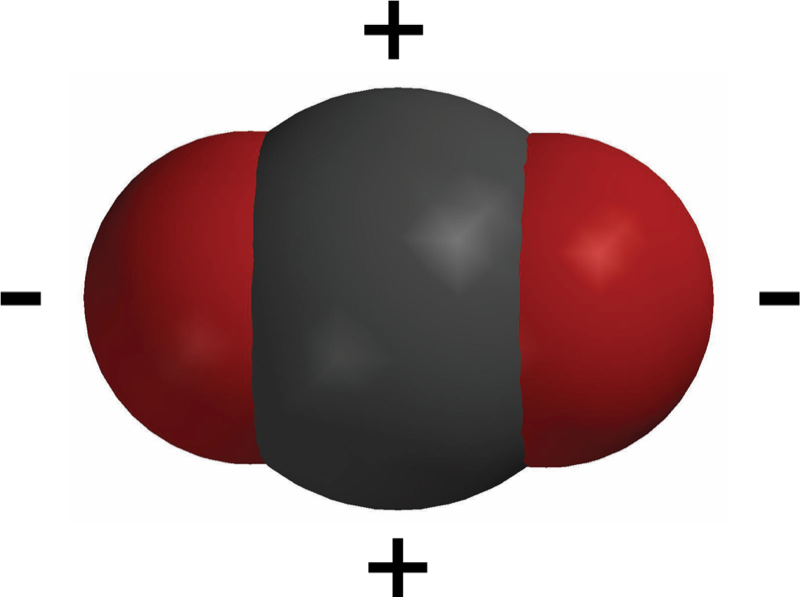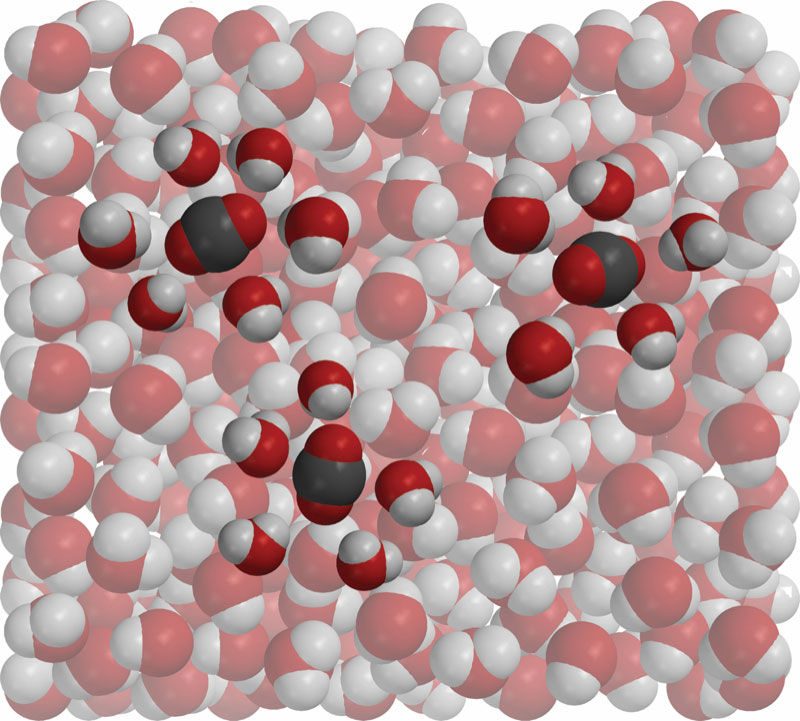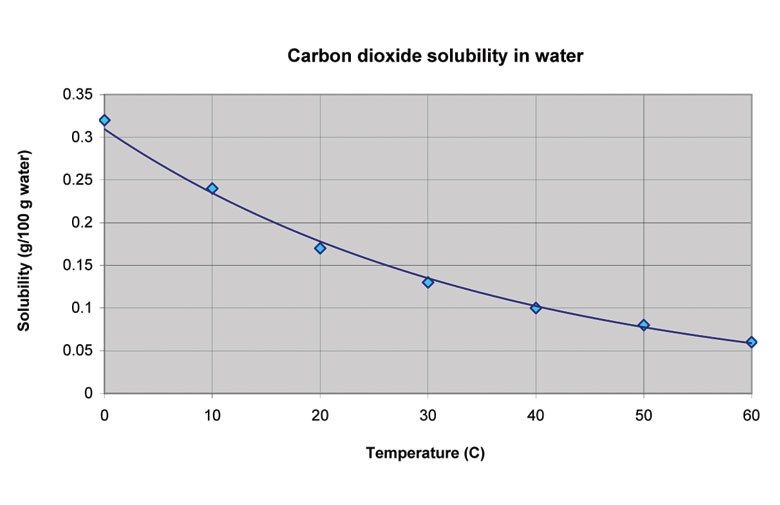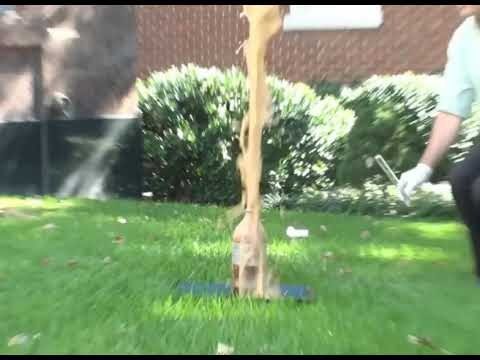Can Gases Dissolve in Water?
Lesson Summary Video for teachers
Note: This video is designed to help the teacher better understand the lesson and is NOT intended to be shown to students. It includes observations and conclusions that students are meant to make on their own.
Key Concepts
- Gases can dissolve in water.
- The dissolving of a gas in water depends on the interaction between the molecules of the gas and the water molecules.
- The amount of gas that can be dissolved in water depends on the temperature of the water.
- More gas can dissolve in cold water than in hot water.
Summary
Students will observe the dissolved carbon dioxide (CO2) in a bottle of club soda. They will help design an experiment to compare the amount of CO2 that stays in cold club soda compared to warmer club soda.
Objective
Students will be able to explain, on the molecular level, how a gas dissolves in water. They will also be able to explain why the gas comes out of solution faster in warm water than in cold water.

Safety
Be sure you and the students wear properly fitting goggles. Warn students not to eat the M&M. Use caution when handling hot water.
Materials for the Demonstration
Unopened 1-liter bottle of club soda, which will also be used in the activity.
Materials for each group
- Club soda
- 3 clear plastic cups
- 1 M&M
- Pipe cleaner
- Hot water
- Cold water
- 2 deli containers (that cups easily fit inside)
Download All Lesson 5.8 Resources
Get the entire lesson plan and Student Activity Sheet for "Lesson 5.8 - Can Gases Dissolve in Water?"
Online Assignments
Supplement in-class learning with interactive, multimedia-rich Google Forms lesson modules, perfect for reinforcing key chemistry concepts and scientific investigation skills.
Instructions
1 Engage
Step 1
Show students the bubbles that appear when a new bottle of soda is opened.
Remind students that they have seen that some solids and liquids can dissolve in water (Chapter 5, Lessons 5 and 7).
Ask students:
- Do you think that gases can dissolve in water?
The idea of a gas dissolving may seem strange to students, but this demonstration will help them realize that gases can dissolve in water.
Materials
Unopened 1-liter bottle of club soda
Teacher Preparation
Remove the label from a 1-liter bottle of carbonated water.
Ask students:
- How is a bottle of carbonated water different from a regular bottle of water?
Students will probably say that carbonated water has bubbles. - Do you see any bubbles in the carbonated water?
They shouldn’t see any, yet.
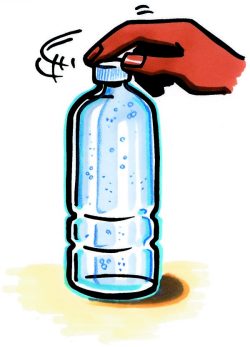
Procedure
- Very slowly unscrew the bottle cap.
- Wait a few seconds to allow students to observe the bubbles.
- Tighten the cap on the bottle.
Expected Results
When the cap is loosened, many bubbles will appear throughout the soda and rise through the water to the surface, where they pop. When the cap is tightened, fewer bubbles will form.
Ask students:
- What did you observe when I opened and then closed the bottle of soda?Bubbles appeared only when the bottle was opened. The bubbles stopped forming when the bottle cap was tightened.
- What is the gas that makes these bubbles?
Carbon dioxide (CO2) - Where was the CO2 before the bottle was opened?
The carbon dioxide was dissolved in the water.
Step 2
Explain that carbonated water is made of carbon dioxide gas dissolved in water.
Tell students that at a soda factory, carbon dioxide gas is added to cold water under high pressure to make carbonated water. The pressure forces more gas to dissolve than ordinarily would.
Project the image CO2 Molecule.
Point out that a molecule of carbon dioxide has a slight negative charge near the oxygen and a slight positive charge near the carbon. CO2 is soluble because water molecules are attracted to these polar areas. The bond between carbon and oxygen is not as polar as the bond between hydrogen and oxygen, but it is polar enough that carbon dioxide can dissolve in water.
Project the image CO2 Dissolved in Water.
Explain that in carbonated water, molecules of carbon dioxide are thoroughly mixed and dissolved in water. This is similar to molecules of sucrose, sodium and chloride ions from salt, or the molecules of isopropyl alcohol, which students dissolved in water in previous activities in this chapter. Point out that when dissolved, the molecules of CO2 are not like tiny little bubbles of gas mixed in the water. Instead, single molecules of CO2 are surrounded by water molecules.
Let students know that although the CO2 dissolves, the molecules are not attracted as strongly by the water molecules as substances like salt or sugar. Due to these weaker attractions, the molecules of CO2 come out of solution relatively easily. This is why soda becomes flat if it is left uncapped for too long.
2 Evaluate
Give each student an activity sheet.
- Lesson 5.8 Student Activity Sheet PDF | DOCX | Google Doc
- Lesson 5.8 Activity Sheet Answers PDF | DOCX | Google Doc
Download the student activity sheet, and distribute one per student.
The activity sheet will serve as the “Evaluate” component of each 5-E lesson plan. The activity sheets are formative assessments of student progress and understanding. A more formal summative assessment is included at the end of each chapter.
Students will record their observations and answer questions about the activity on the activity sheet. The Explain It with Atoms and Molecules and Take It Further sections of the activity sheet will either be completed as a class, in groups, or individually depending on your instructions. Look at the teacher version of the activity sheet to find the questions and answers.
3 Explore
Step 3
Have students add objects to carbonated water to see if they can get carbon dioxide gas to come out of solution.
Ask students:
- Aside from shaking soda, or leaving it uncovered, are there other ways to make carbon dioxide gas come out of carbonated water?
Tell students that objects can be placed in the soda that can cause the carbon dioxide to bubble out of the soda.
Question to Investigate
How can you make carbon dioxide gas come out of solution?
Materials for Each Group
- Club soda in clear plastic cup
- 2 clear plastic cups
- M&M
- Pipe cleaner
Teacher Preparation
Immediately before the activity, use the bottle of carbonated water from the demonstration to pour about ¾ cup of carbonated water into a clear plastic cup for each group.
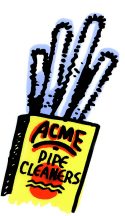
Procedure
- Evenly divide the club soda among the 3 clear plastic cups. Push two of these cups aside to use later.
- Place a pipe cleaner in the soda and observe.
- Place an M&M in the soda and observe.
Expected Results
Bubbles form on the pipe cleaner. Bubbles also form on the M&M and rise to the surface.
Ask students:
- Where did the gas bubbles that you observed come from?
There were molecules of carbon dioxide dissolved in the water. - Where did the carbon dioxide gas that was dissolved in the water go?
The carbon dioxide bubbles rose to the surface and popped, releasing carbon dioxide into the air.
Explain that the objects placed in the soda had tiny bumpy areas where the carbon dioxide molecules collected. When enough of the molecules were together in a certain area, they became a bubble. When this bubble, which is less dense than the water around it, became big enough, it floated to the surface and popped, releasing carbon dioxide gas into the air.
Ask students:
- While drinking soda pop with a straw, you may have noticed that bubbles form on the outside of the straw. Now that you have done this activity, why do you think these bubbles form on the straw?
Even though the straw looks smooth, it also has tiny bumpy areas, where molecules of carbon dioxide collect. When enough of them collect in an area, they become a bubble of carbon dioxide gas.
Step 4
Discuss how to find out whether temperature affects how quickly gas escapes from carbonated water.
Ask students:
- Would you expect carbon dioxide to stay dissolved better in hot or cold water? Hint: Soda pop is kept in the refrigerator after it is opened.
Students will discover the answer to this question as they do the following activity. - How could you set up an experiment to find out whether carbon dioxide stays dissolved better in water that is warmed or water that is cooled?
Students should realize that they will need two cups of carbonated water. They will then need to heat one and cool the other. One simple way to heat and cool the cups is to use a hot or cold-water bath like the one described in the procedure. - If more carbon dioxide gas escapes from the soda, will there be more or fewer bubbles popping at the surface?
There will be more bubbles popping at the surface. - If more carbon dioxide gas stays dissolved, will there be more or fewer bubbles popping at the surface?
There will be fewer bubbles popping at the surface.
Conclude that students can compare how fast carbon dioxide gas escapes or stays in solution by comparing the quantity of bubbles they see rise to the surface and pop. More bubbles rising and popping means more gas is escaping from the solution. Fewer bubbles rising and popping means more gas is remaining in the solution.
Step 5
Have students warm and cool 2 cups of carbonated water to find out if temperature affects the solubility of carbon dioxide.
Question to Investigate
Does carbon dioxide stay dissolved better in water that is warmed or water that is cooled?
Materials for Each Group
- Carbonated water in 2 clear plastic cups
- Hot water (about 50 °C)
- Cold water (about 5 °C)
- 2 deli containers (that cups easily fit in)
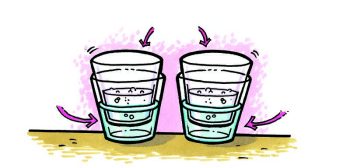
Procedure
- Get the two cups of carbonated water that you moved aside earlier.
- Fill one empty deli container about ⅓ of the way with ice cold water and another about ⅓ of the way with hot tap water.
- Place each of the cups of carbonated water into the cold and hot water, as shown.
- Watch the surface of the soda in each cup of carbonated water.
Expected Results
More bubbles form and rise to the surface in the carbonated water that is placed in hot water.
Step 6
Discuss student observations.
Students should realize that dissolved gas comes out of solution faster when soda is warm than when it is cold. The reverse is also true: Dissolved gas tends to stay dissolved better in cold soda.
Ask students:
- Does carbon dioxide stay dissolved better in hot water or in cold water?
Carbon dioxide stays dissolve better in cold water. - How do you know?
More gas escapes from the soda placed in hot water. - Based on what you observed in this experiment, why do you think people store soda pop that has been opened in the refrigerator?
Since less carbon dioxide escapes when soda is colder, keeping soda in the refrigerator prevents the soda from going flat.
4 Explain
Step 7
Explain why carbon dioxide gas escapes from hot water faster than it does from cold water.
Remind students that carbon dioxide gas is ready to come out of carbonated water no matter the temperature of the water. This is because gas molecules and water molecules are somewhat attracted to each other, but not very much. All you have to do is leave a bottle of soda pop open and the carbon dioxide will come out on its own, making your soda pop flat. Warming the soda increases the motion of the water and carbon dioxide molecules, making their attachments even looser and allowing the gas to escape even faster.
Note: Even a soda that we call “flat” has a little carbon dioxide in it because some CO2 from the air dissolves into the water.
Step 8
Help students relate their observations to the graph of the solubility of carbon dioxide in water.
Project the image Solubility Graph for CO2.
Look at the graph to see how the concentration of carbon dioxide in water changes with temperature.
Ask students:
- As the temperature increases, is carbon dioxide more soluble in water or less soluble in water?
Carbon dioxide is less soluble as the temperature of the water increases. - Does this graph match or not match your observations? Explain.
This graph matches student observations in the activity. As the carbonated water was warmed, more CO2 left the solution. Since more gas left, less was dissolved in the warmer water. - What do the graphs tell you about the solubility of carbon dioxide compared to sucrose, as temperature increases?
The curve showing the solubility of carbon dioxide goes down as the temperature of the water increases, while the curve showing the solubility of sucrose goes up as the temperature of the water increases. More sucrose can dissolve in hot water than in cold. But for carbon dioxide, more can dissolve in cold water than in hot.
5 Extend
Step 9
Relate students’ experiences with the solubility of carbon dioxide to the solubility of oxygen.
Tell students that there is another common example of a gas dissolved in water. The water in which fish and other aquatic creatures live contains dissolved oxygen gas. These creatures use their gills to get the oxygen from the water in order to stay alive. Like the solubility of carbon dioxide in water, the solubility of oxygen decreases as the temperature increases.
Ask students:
- During a long hot summer, you may notice fish gulping air at the surface of a pond. Why do you think the fish come to the surface like this, instead of breathing dissolved oxygen in the water the way they normally do?
Like carbon dioxide, the concentration of dissolved oxygen is also affected by temperature. Cold water can hold more dissolved oxygen than warm water. In winter and early spring, when the water temperature is low, the dissolved oxygen concentration is high. In summer and early fall, when the water temperature is high, the dissolved-oxygen concentration is lower. - Coal-burning power plants heat water to turn turbines to make electricity. After using the water, it is cooled and then returned to the river or lake it came from. Why is it important to cool the water before returning it to the river?
Dissolved gases, like oxygen for fish and carbon dioxide for aquatic plants, would escape if the returned water were hot. Cool water helps keep gases dissolved, which fish, other aquatic creatures, and underwater plants need.
Step 10
Have students observe and explain what happens when Mentos candies are dropped in a bottle of Diet Coke.
Ask students:
- Has anyone ever seen the Diet Coke and Mentos demonstration?
If students have seen it, ask them to describe the activity. An entire packet of Mentos mints is dropped into a 2-liter bottle of carbonated beverage, usually Diet Coke. The soda pop shoots out of the bottle with a lot of force and goes high into the air.
Project the video Mentos and Diet Coke Demo.
If you are willing to do this demonstration, it must be done outside.
Remind students that the pipe cleaner and the M&M they added to carbonated water caused CO2 to escape from the solution. Mentos and Diet Coke work in the same way. On the microscopic level, the surface of the mint is rough with many tiny bumps and pits. When the candy is added to the soda pop, carbon dioxide molecules adhere to these tiny spots called nucleation points. More carbon dioxide molecules collect in these areas, forming bubbles. The bubbles of carbon dioxide form quickly and grow in all directions but can only escape from the top of the bottle. Because many bubbles are forming and rising to the surface all at once, they bring a large amount of the soda pop with them as they come out of the soda, creating a “fountain” of soda.
What is the 5-E format?
The 5-E instructional model is an approach to teaching and learning that focuses on active engagement, inquiry-based learning, and collaboration.
Downloads
For Students
- Lesson 5.8 Student Activity Sheet PDF | DOCX | Google Doc
For Teachers
- Lesson 5.8 Lesson Plan PDF | DOCX | Google Doc
- Lesson 5.8 Activity Sheet Answers PDF | DOCX | Google Doc
Resources for the entire Chapter 5
- Chapter 5 Student Reading PDF | DOCX | Google Doc
- Chapter 5 Test Bank PDF | DOCX | Google Doc
Interactive Lesson Modules
- Lesson 5.8 Online Assignments Google Form
Have Questions? Visit Help Center
